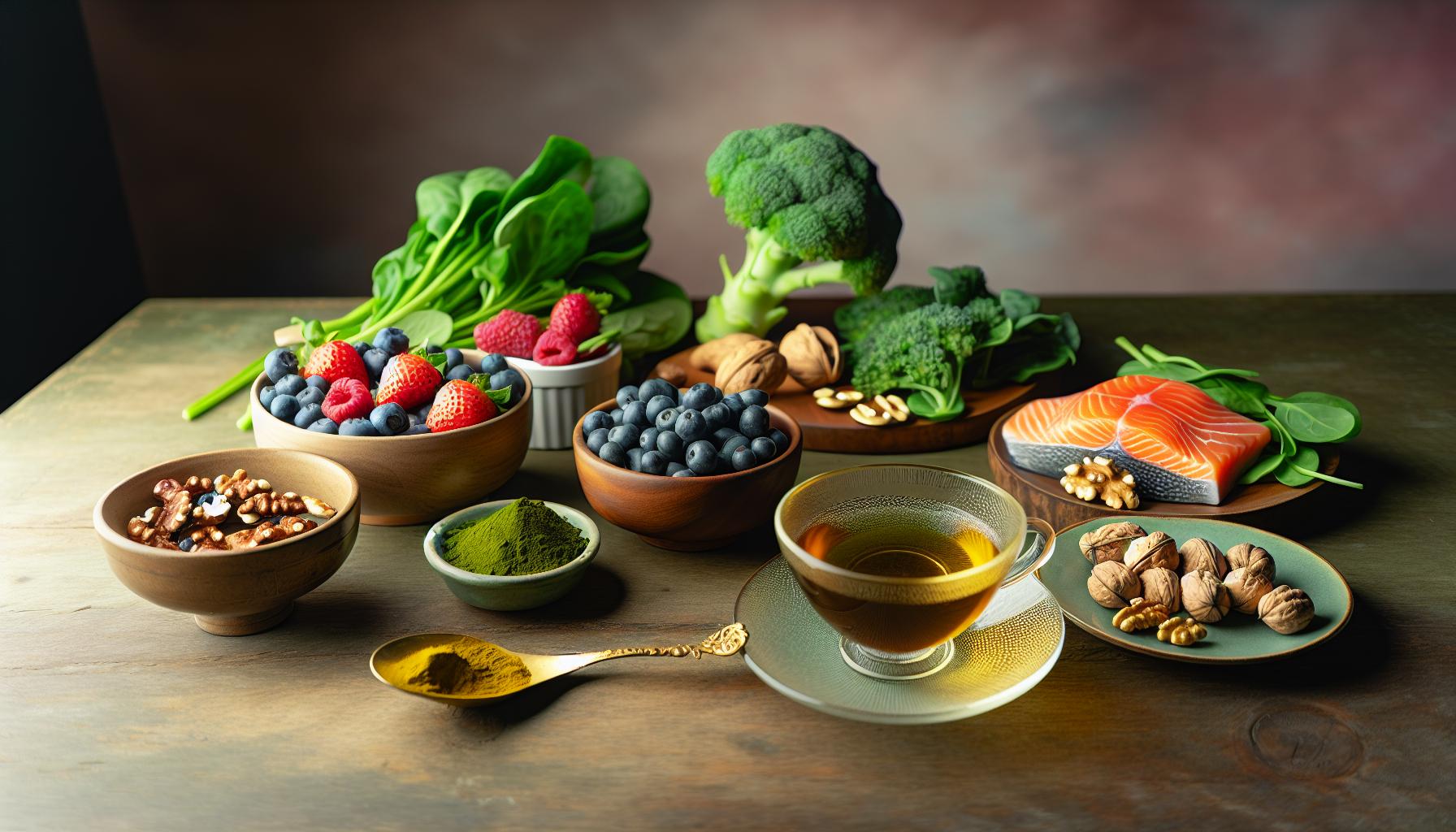Cystic acne can be a daunting challenge, affecting not just your skin, but also your self-esteem and confidence. Did you know that many people can see significant improvement in their skin within just 14 days using natural remedies? This article delves into effective home treatments that can help clear cystic acne and promote healthier skin. Whether you are tired of harsh chemicals or looking for holistic alternatives, addressing the root causes of your skin issues is essential. We understand your desire for clear skin and are excited to share insights that empower you to take control of your skincare journey. Join us as we explore practical solutions that can lead to noticeable results while emphasizing the importance of consulting healthcare professionals for personalized advice. Your journey to clearer skin starts here!
Cystic Acne: Understanding the Causes and Triggers
Cystic acne is one of the most severe forms of acne, often causing deep, inflamed cysts that can be painful and emotionally taxing for those affected. Understanding the underlying causes and triggers of this condition is crucial for effectively tackling it, especially when exploring home remedies aimed at achieving clear skin within a short timeframe.
Several factors contribute to the development of cystic acne. Hormonal fluctuations are significant culprits; during puberty, menstruation, or due to conditions such as polycystic ovary syndrome (PCOS), increases in androgen levels can trigger the sebaceous glands to produce excessive sebum. This excess oil can clog pores and create an environment ripe for bacterial growth. Alongside hormonal changes, genetics play a role; if cystic acne runs in your family, you may be more predisposed to experiencing it yourself.
Other triggers include certain lifestyle and dietary choices. High glycemic index foods, dairy products, and concentration of processed sugars are linked to acne flare-ups, as they can elevate insulin levels and lead to increased oil production. Stress, too, has a significant impact; it causes the body to produce cortisol, which can also exacerbate oil production and lead to inflammation. Environmental factors like humidity and pollution can further irritate the skin, contributing to outbreaks.
To effectively manage cystic acne, it is vital to identify these triggers and incorporate proactive measures into your skincare routine. Implementing a holistic approach that includes monitoring hormonal health, adjusting dietary habits, managing stress, and ensuring proper skincare can empower individuals to achieve clearer, healthier skin. Consulting with a healthcare professional can also provide personalized strategies for managing this challenging condition.
Natural Ingredients for Effective Home Remedies
Engaging with natural ingredients can transform your approach to managing cystic acne, offering a holistic method that harmonizes with your body’s needs. Certain everyday items found in your kitchen or local markets hold remarkable properties that can help soothe inflammation, reduce oiliness, and promote healing. For instance, tea tree oil is renowned for its potent antibacterial and anti-inflammatory properties, making it a favored remedy for acne-prone skin. When diluted with a carrier oil, it can be applied directly to affected areas to diminish the appearance of cysts.
Another powerful ally in your skincare arsenal is aloe vera. Not only is it gentle on the skin, but it also deeply moisturizes while providing anti-inflammatory benefits. You can apply fresh aloe vera gel directly from the plant to provide soothing relief, helping to calm redness and irritation. Similarly, honey, particularly raw or Manuka honey, offers natural antibacterial properties and can act as a humectant, drawing moisture into the skin. Applying a honey mask a few times a week can nurture your complexion while combating bacteria.
Popular Natural Ingredients for Acne Care
- Apple Cider Vinegar: Balances skin pH and possesses antibacterial qualities. Dilute with water before applying.
- Green Tea: Packed with antioxidants, can be used as a toner or applied directly to the skin to reduce inflammation.
- Witch Hazel: A natural astringent that helps minimize pores and reduce excess oil production.
- Neem: Known for its antifungal and antibacterial properties, can be used in oil form or as a powder mixed with a facial mask.
Incorporating these natural ingredients into your skincare routine does not need to be daunting. Start by patch-testing any new remedy on a small area of your skin to ensure you don’t react negatively. Consulting with a dermatologist can also provide insights tailored to your skin type and needs, ensuring that you make informed choices. While these remedies can provide relief and support in achieving clearer skin, remember that consistent application and patience are keys to seeing significant results over time. By embracing a natural approach, you empower yourself to take charge of your skin health with confidence.
Step-by-Step Guide to Create Your Remedy

Creating effective home remedies for cystic acne can empower you on your journey to clearer skin. With just a few natural ingredients and a clear step-by-step approach, you can develop treatments that nurture your skin and help alleviate acne symptoms. Here’s how to create your remedy tailored specifically for cystic acne.
To begin, gather your ingredients. Some widely-used natural options include tea tree oil, aloe vera, and raw honey. You might also consider apple cider vinegar for its pH-balancing properties. Once you’ve selected your ingredients, it’s essential to decide on a base for your remedy. For instance, if you’re using tea tree oil, mix it with a carrier oil like coconut or jojoba oil to dilute its potency and minimize irritation.
The actual preparation is straightforward. For example, if you opt for a simple honey mask, take a tablespoon of raw honey and apply it directly to the affected areas. Leave it on for about 15-20 minutes, allowing the antibacterial properties to work their magic before rinsing with lukewarm water. For an aloe vera mask, scoop out fresh gel from the aloe plant, apply it to your skin, and let it sit for half an hour to soothe the inflammation.
Recipe Examples
- Tea Tree Oil Spot Treatment: Mix 1 drop of tea tree oil with 1 teaspoon of your chosen carrier oil. Apply it directly to the cysts before bed.
- Aloe Vera and Honey Mask: Combine 1 tablespoon of aloe vera gel with 1 tablespoon of honey for a moisturizing treatment. Use twice a week.
- Apple Cider Vinegar Toner: Dilute 1 part apple cider vinegar with 3 parts water. Apply with a cotton pad to balance skin pH daily.
Lastly, don’t forget to patch-test any remedy on a small area of skin to ensure you don’t have a negative reaction, especially if you have sensitive skin. Consistency is key; applying your chosen remedies regularly over a couple of weeks will yield better results. Always remember, while these natural treatments can be effective, consulting with a dermatologist for personalized advice is vital, especially for persistent or severe cystic acne. This empowers you not only to manage your skin health but also to make informed decisions suited to your unique skin needs.
How to Implement Your Cystic Acne Routine

Implementing a consistent cystic acne routine is essential to achieving clearer skin, especially when aiming for results in as little as 14 days. One of the most impactful actions you can take is to establish a daily skincare regimen that thoughtfully incorporates your chosen home remedies, along with a few essential cleansing and moisturizing steps. Adhering to this routine not only helps to mitigate active breakouts but also addresses the underlying factors contributing to cystic acne.
Start your day with a gentle cleanser that is suitable for acne-prone skin to remove impurities without stripping your skin’s natural oils. After cleansing, apply your selected home remedy-like the tea tree oil spot treatment or the aloe vera and honey mask mentioned earlier. While the mask can be a part of your weekly routine, spot treatments can be used as needed, especially on inflamed cysts. After allowing the remedy to absorb for a reasonable amount of time, make sure to follow up with a lightweight, non-comedogenic moisturizer to keep your skin hydrated.
In the evenings, repeat the cleansing process and incorporate your home remedies to continue the healing process overnight. This consistency is crucial; by maintaining it, you signal to your skin that it can begin the repair cycle, allowing for noticeable changes over the two-week period. Additionally, consider adding an exfoliating step a few times a week using a gentle exfoliant to help shed dead skin cells, clearing clogged pores that often lead to cystic acne.
Your commitment to this routine, combined with empathy and understanding towards your skin’s needs, is your best ally on this journey. Remember that patience and consistency are key-mirroring these values in your skincare approach can lead to significant improvements in your complexion. If at any point you feel overwhelmed or if irritations arise, don’t hesitate to consult a dermatologist, who can provide personalized advice and treatment options tailored to your unique needs.
Essential Lifestyle Changes for Clear Skin

Making meaningful lifestyle changes can have a profound impact on your skin’s health, especially when dealing with cystic acne. Beyond topical treatments and home remedies, small adjustments in your daily habits can help stimulate clearer skin and reduce breakouts. For instance, stress management is crucial, as elevated stress levels can lead to increased cortisol production, which may exacerbate acne flare-ups. Consider integrating activities such as yoga, meditation, or even regular physical exercise into your routine, all of which contribute to lower stress levels and improved overall well-being.
Maintaining proper hydration is equally essential. Drinking adequate amounts of water throughout the day can aid in flushing out toxins and keeping your skin moisturized from the inside. Aim for at least 8 glasses a day, and consider incorporating foods with high water content, such as cucumbers, oranges, and watermelons.
Another critical aspect is ensuring quality sleep. Aim for 7 to 9 hours of uninterrupted sleep each night, as this is when your body undergoes repair and regeneration. Sleep deprivation can lead to imbalance in hormone levels and increase inflammation, both of which can worsen acne. Establishing a relaxing nighttime routine can help signal to your body that it’s time to wind down, promoting better sleep quality.
Lastly, remember that hygiene extends beyond your skincare products. Regularly changing pillowcases, towels, and face masks can help minimize the transfer of bacteria and oils back onto your skin, further reducing the risk of breakouts. By consciously making these lifestyle changes, you empower yourself on your journey to achieve clearer skin, complementing the benefits of your skincare routine.
Dietary Choices: Foods That Fight Cystic Acne

Eating the right foods can significantly influence your skin’s health, particularly when dealing with stubborn cystic acne. Certain dietary choices are known to help combat inflammation and promote clearer skin, making them essential components of a holistic approach to acne management. Research indicates that diets high in refined sugars and dairy can exacerbate acne symptoms by triggering hormonal fluctuations and promoting inflammation, which may lead to pore blockages and breakouts. By focusing on nutrient-dense, anti-inflammatory foods, you can create conditions less favorable for cystic acne to thrive.
Anti-Inflammatory Foods
Incorporating anti-inflammatory foods into your diet can help reduce the severity of cystic acne. Some beneficial options include:
- Fatty Fish: Rich in omega-3 fatty acids, salmon and sardines can help decrease inflammation and promote healthy skin.
- Nuts and Seeds: Almonds and chia seeds provide essential fatty acids and vitamin E, which support skin barrier function and may help reduce acne flare-ups.
- Leafy Greens: Spinach and kale are packed with vitamins and minerals that support skin health and overall well-being.
- Fruits and Berries: Blueberries, strawberries, and oranges are loaded with antioxidants to fight oxidative stress and inflammation.
Foods Rich in Zinc
Zinc plays a crucial role in skin health, aiding in cell repair and regeneration while helping to regulate oil production. Foods high in zinc include:
- Legumes: Chickpeas, lentils, and beans can be excellent plant-based sources of zinc.
- Quinoa: This whole grain provides not only zinc but also protein and fiber, contributing to overall skin health.
- Lean Meats: If not following a vegetarian diet, consider lean meats like turkey and chicken.
Limit Processed and Sugary Foods
To create a diet conducive to clear skin, it’s equally important to limit foods known to cause inflammation and hormonal imbalances. Try to avoid:
- Sugary snacks and beverages that can spike insulin levels, leading to increased oil production.
- Processed and fried foods that may contribute to inflammation.
- Dairy products for those sensitive to lactose, as they can exacerbate acne for some individuals.
Taking an integrative approach to your diet can bolster your efforts in managing cystic acne. Remember that while dietary changes can significantly impact skin health, they should complement other treatment methods. Always consult with a healthcare professional or a registered dietitian before making significant dietary changes, particularly if you have underlying health conditions. Embracing a balanced diet alongside proper skincare routines can pave the way toward achieving clearer, healthier skin.
Skin Care Techniques: Do’s and Don’ts
Effective skin care techniques can significantly impact your journey toward managing cystic acne. While dealing with this challenging skin condition, understanding what to do and what to avoid is crucial for achieving clearer skin. A carefully curated routine not only helps reduce breakouts but also supports overall skin health.
One of the foundational do’s is to maintain a consistent cleansing regimen. It’s essential to cleanse your face twice daily using a gentle, non-comedogenic cleanser that targets acne without stripping the skin of its natural oils. Look for ingredients such as salicylic acid or benzoyl peroxide, which can assist in unclogging pores and reducing inflammation. Additionally, be sure to gently pat your face dry with a clean towel rather than rubbing it, which can irritate active blemishes.
When it comes to moisturization, do not overlook the importance of using a suitable moisturizer. Many people with cystic acne fear that moisturizing will worsen their condition, but a lightweight, oil-free moisturizer can help maintain skin hydration without clogging pores. Look for products labeled as “non-comedogenic.”
What to Avoid
On the other hand, it’s equally important to recognize common pitfalls. First and foremost, avoid picking or popping cystic acne lesions, as this can lead to further inflammation, scarring, or infection. Additionally, refrain from using harsh scrubs or exfoliants that may irritate the skin and worsen the situation.
Another essential don’t is to skip sunscreen. Many acne medications can increase skin sensitivity to the sun, making protection crucial. Opt for a broad-spectrum, oil-free sunscreen daily. Moreover, be cautious with the application of heavy makeup products that may clog your pores or irritate sensitive skin. Instead, consider mineral-based makeup that is less likely to cause breakouts.
With these do’s and don’ts in mind, you can take proactive steps toward managing cystic acne more effectively. Each small adjustment can contribute to healthier skin, helping you feel more confident and empowered on your path to clear skin. Always consult with a dermatologist for personalized recommendations, especially when considering new products or treatments.
When to Consult a Dermatologist for Cystic Acne
Cystic acne can significantly impact your self-esteem and overall well-being. While many individuals attempt to manage their breakouts with home remedies and over-the-counter products, there are critical moments when professional intervention is essential. Recognizing when to consult a dermatologist can greatly influence the effectiveness of your treatment and the health of your skin in the long run.
If your cystic acne persists despite trying various home remedies or topical treatments for several weeks, it’s time to reach out to a healthcare professional. Cystic acne is not just any ordinary breakout; it often requires targeted therapies that might not be available over the counter. Dermatologists can prescribe stronger medications, such as antibiotics or retinoids, that can help reduce inflammation and prevent future outbreaks.
Additionally, you should seek a dermatologist’s advice if you experience severe pain, swelling, or if the acne is accompanied by other symptoms such as fever or significant skin irritation. These signs may indicate an infection that needs to be addressed immediately. Moreover, if your acne is leaving scars or causing hyperpigmentation, a dermatologist can provide specialized treatments, including chemical peels or laser therapy, to minimize skin damage and promote healing.
It’s also vital to consult a dermatologist if your cystic acne has a significant emotional impact on your life. Acne isn’t just a skin issue; it can deeply affect mental health, leading to anxiety and depression. Dermatologists can not only provide effective medical treatment but can also connect you with counseling resources if needed. Taking these steps ensures a holistic approach to your skin health, allowing you to achieve clearer skin and greater self-confidence. Remember, proactive treatment can lead to better long-term outcomes, making it essential to seek professional advice when necessary.
Success Stories: Real Life Transformations
Many individuals suffering from cystic acne have found transformative success stories by implementing a combination of natural remedies and lifestyle changes, often leading to clear skin within just two weeks. For example, Sarah, a 25-year-old graphic designer, faced relentless cystic breakouts that affected her confidence and career. After researching natural skincare methods, she began incorporating ingredients like tea tree oil and honey into her routine. Within 14 days, she noticed a significant reduction in inflammation and the size of her cysts. Sarah attributes her success not just to the remedies but also to her dedication to maintaining a balanced diet and ensuring proper hydration.
John, a college athlete, struggled with cystic acne for years. After feeling frustrated with the lack of results from over-the-counter treatments, he decided to take a different approach by adopting a holistic routine that included daily facial steaming and the use of a gentle exfoliant made from oatmeal and yogurt. His commitment to this new routine, along with dietary adjustments-reducing saturated fats and increasing fruits and vegetables-led him to experience a dramatic improvement in his skin within just a couple of weeks. John emphasized the importance of mental resilience during this journey, sharing how focusing on his overall well-being helped him feel empowered rather than defeated by his skin condition.
- Implementing Natural Remedies: Many individuals have succeeded by blending natural ingredients like aloe vera and chamomile, which boast anti-inflammatory properties, into their routine.
- Adopting a Holistic Lifestyle: Integrating stress management techniques such as yoga and meditation has proven beneficial for individuals, enhancing their overall skin health.
- Dietary Changes: Reducing sugar intake and emphasizing omega-3 fatty acids found in fish or flaxseed has been linked to decreased inflammation and clearer skin.
These personal accounts highlight the power of perseverance and informed decisions in the quest for clearer skin. It’s essential to remember that while many have found success with home remedies, individual experiences vary. Consulting with a dermatologist can provide tailored guidance and additional treatment options, especially for those struggling with severe cases. The stories of transformation not only inspire but also empower others to take proactive steps toward their skin health, showcasing the possibility of reclaiming confidence one day at a time.
Common Misconceptions About Cystic Acne Treatment
Misunderstandings about cystic acne treatment can lead to frustration and ineffective strategies for those seeking clearer skin. Many believe that cystic acne is solely a result of poor hygiene or dietary choices, which can create an overwhelming sense of guilt or inadequacy. In reality, this condition is often rooted in complex factors, including hormonal fluctuations, genetics, and skin types. While maintaining cleanliness and a healthy diet is beneficial, it is crucial to recognize that these factors alone may not resolve cystic acne.
Another common misconception is that harsh treatments are the best approach. People often think that aggressive exfoliation or the frequent use of strong medications will lead to quicker results. However, over-treating the skin can cause irritation and exacerbate acne symptoms. Gentle, natural remedies such as oatmeal masks or tea tree oil can effectively reduce inflammation without damaging the skin’s protective barrier. This softer approach is often more sustainable and leads to better long-term results.
Additionally, many assume that once they find a remedy that seems to work, they can stop putting effort into their skincare routine. Cystic acne treatment is an ongoing process that requires consistency and adaptation. Regularly assessing and updating one’s skincare regimen based on changes in skin condition, lifestyle, and external factors is essential for maintaining clear skin. Incorporating a range of home remedies and lifestyle changes, such as stress management techniques and dietary adjustments, can help create a more holistic and effective approach.
It’s also important to emphasize that what works for one person may not work for another. Cystic acne is highly individual, and what contributes to one person’s breakouts may differ from another’s. Consulting with a dermatologist or skincare professional can provide tailored advice and ensure that any home remedies align with one’s specific skin needs and conditions. Maintaining open communication with healthcare professionals about treatment progress can foster a better understanding of one’s skin and lead to more successful management of cystic acne.
Maintaining Results: Long-Term Skin Health Strategies
Maintaining clear skin, especially after successfully managing cystic acne, goes beyond short-term remedies and requires a holistic approach. The journey to lasting skin health involves understanding your skin’s unique needs, adapting your routine, and following best practices that promote overall well-being. Establishing sound habits can help maintain results and prevent future breakouts, ensuring your skin remains healthy and vibrant.
One fundamental strategy for long-term skin health is consistency in your skincare routine. It’s not just about what products you use, but how regularly you use them. Consider following a simple regimen that includes:
- Gentle cleansing: Use a mild cleanser suitable for acne-prone skin twice daily to remove oil, dirt, and dead skin.
- Moisturizing: Even oily skin benefits from hydration; opt for non-comedogenic moisturizers that won’t clog pores.
- Treatment application: Incorporate products with ingredients like salicylic acid or benzoyl peroxide to manage breakouts.
- Sun protection: Apply broad-spectrum sunscreen daily to prevent skin damage and irritation.
Another critical aspect of maintaining skin health is monitoring your diet and lifestyle choices. Foods rich in antioxidants, vitamins, and minerals can be beneficial; for instance, omega-3 fatty acids found in fish and nuts may help reduce inflammation. Staying hydrated is equally vital-drinking plenty of water assists in flushing out toxins and keeping the skin supple. Implement practices that minimize stress, such as regular exercise, meditation, or engaging in hobbies, as stress can trigger hormonal fluctuations that lead to acne flare-ups.
Moreover, regular appointment with a dermatologist should be a part of your long-term strategy. They can help tailor your skincare regime based on your skin condition, monitor any changes, and provide guidance on effective treatments. Remember, skincare is a personal journey; what works for one individual may not work for another, so adaptability is key. Taking an active role in your skin care and being mindful of changes can lead to more successful maintenance of clear skin over time.
Frequently Asked Questions
Q: What home remedies can help reduce cystic acne in 14 days?
A: Effective home remedies for cystic acne include using tea tree oil for its anti-inflammatory properties, aloe vera for soothing redness, and honey as a natural antibacterial. Incorporating these into your skincare routine can help clear skin, especially when paired with lifestyle changes outlined in our guide.
Q: How long does it take to see results from cystic acne home remedies?
A: Most home remedies for cystic acne can show noticeable improvements in skin clarity within 14 days. Consistent use of remedies, along with a healthy diet and proper skincare techniques, enhances effectiveness for better overall results.
Q: Are there any specific dietary changes that can help cystic acne?
A: Yes, reducing dairy and sugar intake while increasing omega-3 rich foods like fish and walnuts can significantly benefit cystic acne. This dietary approach supports skin health and may help to reduce inflammation.
Q: Can stress impact cystic acne and is there a home remedy for it?
A: Stress can exacerbate cystic acne due to hormonal changes. Incorporating stress-reducing practices like meditation, yoga, or regular exercise into your routine can help mitigate its effects on your skin.
Q: What is the best skincare routine to follow while treating cystic acne?
A: A good skincare routine includes cleansing twice daily with a gentle, salicylic acid-based cleanser, applying targeted treatments with benzoyl peroxide or tea tree oil, and moisturizing with non-comedogenic products. This helps manage cystic acne effectively.
Q: When should I consult a dermatologist about cystic acne?
A: You should consult a dermatologist if cystic acne persists despite home treatments for more than 14 days or significantly impacts your self-esteem. A professional can provide tailored solutions and prescription medications when necessary.
Q: Are there any ingredients to avoid in skincare for cystic acne?
A: Avoid products containing heavy oils, alcohol, and fragrances, which can irritate your skin and worsen cystic acne. Stick to non-comedogenic, gentle formulations for better results.
Q: What are some successful over-the-counter options for cystic acne?
A: Over-the-counter options for cystic acne include products with salicylic acid, benzoyl peroxide, and topical retinoids. These ingredients can help reduce inflammation and unclog pores effectively.
The Way Forward
Achieving clear skin is within your reach with our “Cystic Acne Home Remedy: Clear Skin in 14 Days.” By implementing the strategies discussed, you can take control of your skin health and start your journey towards a more confident you. Don’t wait-start today and experience the transformation! For additional support, dive deeper into our guides on natural remedies for acne and explore holistic approaches to skincare.
Have questions or success stories to share? We’d love to hear from you in the comments below! Remember, each person’s skin is unique, so consulting with a healthcare professional can provide tailored advice for your individual needs. For regular tips and updates, consider signing up for our newsletter. Empower yourself with knowledge and take the next step toward glowing skin now!












